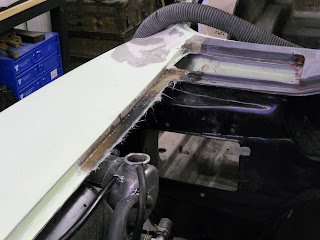The results are in! We will install the 1963 hood with the classic racing strip. We might even paint the 67 hood with the 63 racing strip then hang it in the garage somewhere. That would be cool.
We continue to find odds and ends of things that need to be finished before we shoot the next coat of primer. In this picture I am getting ready to spot weld clips onto the drip rail. These clips will hold the interior door molding.
The same drip rail had to have a tab welded onto the front. This tab fits into a rubber molding.
3M Ultrapro Sealant was used on both drip rails. It's a flexible sealant that can be sanded and painted.
The inside of the door jambs on the car body have been dressed up and prepared for primer.
Tabs of all sorts continue to be a nuisance. The front clip is full of them.
This is a fiberglass clip that was broken and recently repaired. Right below it is a rusted metal clip. This clip and others have been removed and will be replaced after the body is painted.
The lower part of the front end had a couple good size cracks in the fiberglass. These were probably caused by large speed bumps or concrete bumpers. Both have been repaired and are ready for primer.
I found a small super thin area of fiberglass on the left front fender. Turns out there was an air bubble caught in a rivet hold from a couple years ago. The hole was ground out then fiberglassed as shown.
With a flashlight on the backside you can see where the rivet hole was. Because we use clear fiberglass this repair looks unfinished but it's actually a full thickness repair ready for primer. All of the wheel wells were examined to make sure we didn't have similar issues. None were found.
Ty continues to work on the 63 hood. Now that we know this hood is going to be used it will become a priority item to finish.
The hood has lots of issues but all are easily fixed.
And in closing, Ty and I both fit in the Corvette but it's a snug fit. There are several options found on the Internet, one of which is to swap out the 1963 steering wheel (left) for a 1972. The diameter is smaller and it's not as deep. Another option is to install a tilt wheel made by Flaming River. We could just loose a little weight but we prefer to keep out options open. More on this in a later issue.
As always, thanks for watching.











































